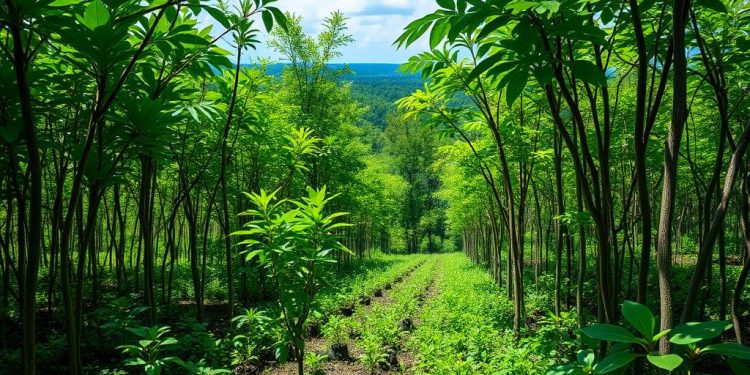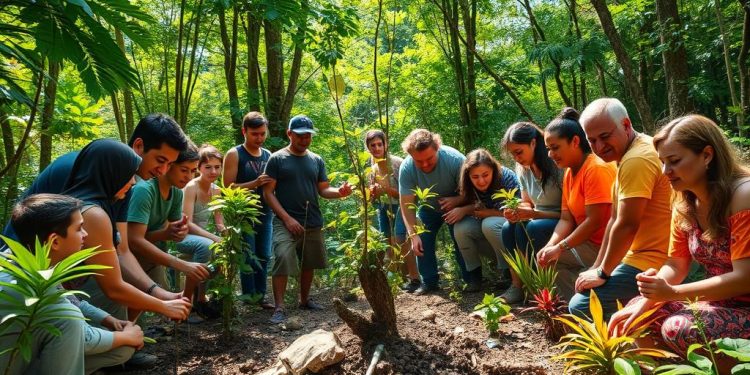In today’s rapidly changing world, wildlife corridors play a pivotal role in promoting species conservation and enhancing biodiversity conservation. These essential pathways enable various species to traverse fragmented landscapes, ensuring their survival amid the challenges posed by urbanization and climate change. The importance of these corridors cannot be overstated; they provide crucial connections between habitats, allowing animal populations to engage in essential activities such as feeding, breeding, and migration.
Understanding the significance of habitat connectivity is vital for implementing effective conservation strategies. By facilitating the movement of wildlife, these corridors not only help maintain healthy ecosystems but also contribute to genetic diversity, which is critical for the resilience of various species. Ultimately, this article will delve into the importance of wildlife corridors in species conservation and explore strategies to enhance their effectiveness for a sustainable future.
Understanding Wildlife Corridors and Their Importance
Wildlife corridors are essential for ensuring the movement and survival of various species across fragmented landscapes. These tracts of land connect two or more habitats, allowing animals to traverse difficult terrain safely. This connectivity is paramount for ecosystem preservation, enabling a robust exchange of genetic material among populations. As a result, species can thrive and adapt more effectively to environmental changes.
Defining Wildlife Corridors
At their core, wildlife corridors represent vital links between habitats. They can range from those spanning across a few miles to expansive networks connecting numerous ecosystems. A remarkable example is the continuous corridors that facilitate the migration of red crabs on Christmas Island, with an estimated 40-50 million crabs undertaking this epic journey. Natural corridors like rivers also serve critical migration routes for fish, contributing to a healthy ecosystem.
Connection to Ecosystem Preservation
Wildlife corridors play a significant role in ecosystem preservation by promoting habitat connectivity. This connectivity supports various species, allowing them to access essential resources for feeding, breeding, and resting. Moreover, corridors help maintain genetic diversity among animal populations. For example, studies indicate that around 50% of mammals benefit from hedgerows, which are important elements of wildlife corridors in regions like the Heart of England Forest. Such hedgerows support approximately 30% of butterflies and 80% of woodland birds.
Further, wildlife corridors can serve as buffers against climate change impacts. They provide safe passage for species that need to relocate due to shifting environmental conditions. As these corridors become more integrated, they ensure that different ecosystems—such as grasslands, forests, wetlands, and coastal areas—remain interconnected. This plays a crucial role in enhancing biodiversity and maintaining ecological balance.
| Wildlife Corridor Features | Examples | Benefits |
|---|---|---|
| Length and Size | Wildlife corridors can span dozens of miles or encompass large areas like the Heart of England Forest (7,000 acres). | Facilitates migration and maintains genetic diversity. |
| Types of Corridors | Green bridges, underpasses, and urban greenways such as the High Line in New York. | Reduces wildlife-vehicle collisions and enhances urban biodiversity. |
| Impact on Ecosystems | Rivers as migration routes for fish and woodland patches for foxes. | Supports a range of species and ecosystem services, such as water purification and carbon sequestration. |
How Wildlife Corridors Facilitate Animal Migration
Understanding the role of wildlife corridors in facilitating animal migration reveals their critical importance to the survival of numerous species. These corridors allow for safe passage across landscapes, enabling large mammals to migrate without encountering the dangers presented by human developments. The natural movements of these animals, such as elk and pronghorn, are essential for accessing seasonal habitats vital for feeding and breeding.
Seasonal Movements of Large Mammals
Seasonal movements are a hallmark of large mammals. Species such as elk and pronghorn cover vast distances, driven by environmental changes. For example, Wyoming’s pronghorn migrate approximately 150 miles each winter to reach essential feeding grounds unavailable in northern regions. This journey is often obstructed by urbanization, leading to increased risks where wildlife-vehicle collisions become common. In the United States, an estimated one to two million such collisions occur annually, highlighting the need for better habitat connectivity.
Case Study: The Elk Migration
Elk migration represents a classic example of how wildlife corridors can enhance animal migration. In Wyoming, elk typically roam hundreds of miles between summer and winter ranges. The National Elk Refuge has implemented crucial measures like “elk jumps” to ensure safe transit, thus reducing the likelihood of vehicle encounters during migration periods. Such efforts illustrate how wildlife corridors can significantly improve survival rates for these majestic animals while supporting ecological balance. As wildlife corridors become more established, conservationists can work towards preserving these critical migratory paths for existing and future generations of large mammals.
The Impact of Habitat Connectivity on Endangered Species
Understanding the relationship between habitat connectivity and the survival of endangered species is essential for conservation efforts. Habitat connectivity plays a pivotal role in promoting genetic diversity within animal populations. When habitats become fragmented, it often results in isolated groups of animals. This isolation can lead to inbreeding and a decline in genetic diversity, making populations more susceptible to diseases and environmental changes. For instance, the Florida panther struggled in the 1990s with a population of fewer than 30 individuals, largely due to habitat loss and hunting.
Understanding Genetic Diversity in Animal Populations
Genetic diversity is crucial for the adaptability of endangered species. An increased gene pool enhances resilience against disease outbreaks and environmental stressors. The Florida panther population rebounded to approximately 230 individuals after genetic restoration efforts in 2017. Conservation strategies that improve habitat connectivity can foster gene flow between populations, allowing for a more robust genetic ecosystem.
Barriers and Their Consequences
Physical barriers such as roads and urban developments significantly hinder wildlife movement, complicating conservation efforts. These barriers contribute to wildlife-vehicle collisions, costing the nation over $8 billion annually. In California alone, from 2015 to 2018, reported wildlife-vehicle collisions surpassed 26,000, resulting in over $1 billion in costs, not including unreported incidents. Legislative measures in various states, including Florida’s commitment of $100 million annually for land conservation from the Seminole Tribe gambling compact and New Mexico’s $5 million for a Wildlife Corridors Fund, highlight the increasing awareness and urgency of improving habitat connectivity.
| State | Funding Source | Amount | Purpose |
|---|---|---|---|
| Florida | Seminole Tribe Gambling Compact | $100 million (annually) | Land purchases and conservation easements |
| New Mexico | General Fund | $5 million | Wildlife Corridors Fund |
| Utah | Non-lapsing Funding | $1 million | Highway construction related to wildlife accident prevention |
| Wyoming | Wildlife Trust Fund | $1 million | Fish passage and barrier removal projects |
Enhancing habitat connectivity not only aids in the survival of endangered species but also fosters healthier ecosystems overall. Awareness of the dire impacts of fragmented habitats encourages ongoing efforts to remove barriers and promote wildlife corridors. As you engage with these developments, consider how each initiative contributes to preserving genetic diversity and improving the outlook for endangered species.
Wildlife Corridors and the Mitigation of Human-Wildlife Conflicts
As urban areas expand, the tension between wildlife and human populations can escalate. The establishment of wildlife corridors serves as a proactive measure to address these challenges. Through the implementation of these corridors, you can significantly reduce the incidence of human-wildlife conflicts and promote a safer environment for both humans and wildlife.
Reducing Vehicle Strikes through Safe Passageways
Wildlife corridors play a crucial role in reducing vehicle strikes as animals navigate increasingly crowded landscapes. Millions of wild animals lose their lives each year due to collisions with vehicles, often occurring at the edges of protected areas. Incorporating safe passageways, such as underpasses and overpasses, into these corridors creates paths for wildlife to cross roads without danger. This strategy not only safeguards animal populations but also protects communities from potentially dangerous encounters with wildlife on roadways.
Promoting Peaceful Coexistence Between Humans and Wildlife
Wildlife corridors also foster peaceful coexistence between humans and wildlife. By keeping animal habitats separate from human encroachments, these corridors help minimize direct encounters that can result in conflict. Engaging local communities in conservation efforts encourages education and advocacy for the benefits of coexistence. Through programs like “Payments for Enhancing Coexistence,” participants can gain economic support and recognize the intrinsic value of maintaining biodiversity. Implementing such measures can dramatically improve the relationship between wildlife and communities while ensuring sustainable resource management.
The Role of Wildlife Refuges in Creating Effective Corridors
Wildlife refuges are essential in establishing effective corridors that facilitate animal movement across various landscapes. These protected spaces not only serve as sanctuaries for diverse species but also play a crucial role in broader conservation efforts. Collaborative work with landowners enhances habitat connectivity, fostering partnerships that can help maintain and expand wildlife corridors linking refuges to surrounding areas.
Collaborative Efforts with Landowners
Partnerships with local landowners are vital in implementing strategies that enhance wildlife corridors. By working together, communities can create a network of safe passages that allow species to thrive. Successful initiatives have seen landowners participating actively in conservation programs, ensuring that natural habitats are preserved and restored. These collaborative efforts significantly contribute to the overall health of ecosystems, while also supporting the wildlife refuges that these species depend on.
Success Stories in Refuge Management
Numerous success stories highlight the effectiveness of wildlife refuges in managing effective corridors. For instance, Everglades Headwaters National Wildlife Refuge, covering 150,000 acres, supports 89 listed species, including the endangered Florida panther. The refuge serves as a critical habitat, connecting essential tracts of land, though it requires $20 million from the Land and Wildlife Conservation Fund to further enhance these corridors. Initiatives like the construction of wildlife underpasses at Laguna Atascosa National Wildlife Refuge demonstrate how well-planned refuge management can lead to remarkable successes in wildlife conservation. Such efforts underline the importance of strategic, integrated management in fostering effective corridors vital for maintaining biodiversity.
Strategies for Enhancing Wildlife Corridors
Enhancing wildlife corridors requires a strategic approach that encompasses various methods to ensure their effectiveness. One crucial aspect involves innovative engineering solutions aimed at creating safe passageways for wildlife, particularly in areas where roads and urban developments pose significant challenges. Implementing these structures enables various species to navigate fragmented landscapes without the constant threat posed by vehicles.
Engineering Solutions: Wildlife Underpasses and Overpasses
Wildlife underpasses and overpasses offer effective engineering solutions that significantly reduce the risk of wildlife-vehicle collisions. By allowing animals to cross roads safely, these structures not only protect wildlife but also reduce accidents involving humans. Studies indicate that constructing wildlife crossing infrastructure can potentially eliminate up to 89% of such collisions. For instance, after the introduction of crossing structures in Wyoming, wildlife-vehicle collisions dropped by an impressive 81%, enhancing safety for both wildlife and motorists.
Restoration of Natural Habitats
The restoration of natural habitats plays an equally important role in enhancing wildlife corridors. Efforts to remove invasive species and increase native vegetation positively impact the health of these corridors. By providing essential areas for feeding, breeding, and migration, restored habitats support a wider array of wildlife. Integrating habitat restoration with engineering solutions fosters a cohesive environment where wildlife can thrive while maintaining genetic diversity. This multifaceted strategy is crucial for encouraging the resilience of species, especially in the face of climate change and urban sprawl.
| Strategy | Description | Impact |
|---|---|---|
| Engineering Solutions | Construction of underpasses and overpasses for safe wildlife passage across roads. | Potentially eliminates up to 89% of wildlife-vehicle collisions. |
| Habitat Restoration | Removal of invasive species and reintroduction of native vegetation. | Supports feeding, breeding, and migration for diverse wildlife populations. |
| Integrated Approach | Combining engineering and habitat restoration efforts. | Enhances overall corridor effectiveness, promoting species resilience. |
Conclusion
Wildlife corridors play a critical role in species conservation by providing essential pathways for wildlife movement, promoting habitat connectivity, and ensuring the survival of biodiversity in our increasingly fragmented environments. These corridors support animal migration, enhance genetic diversity, and reduce the risks of inbreeding, which are vital for the long-term health of species. As you consider the landscape around you, remember that these corridors facilitate the necessary movements for securing food, breeding sites, and new territories, which are essential for thriving populations.
The importance of wildlife corridors is amplified in the context of sustainability and climate resilience. By allowing species to migrate to more suitable habitats, they have the potential to mitigate the adverse effects of climate change. In addition, maintaining these critical connections contributes not only to ecological balance but also benefits humans through improved water quality and increased pollination services. Ultimately, effective wildlife corridors create a ripple effect, enhancing both ecological integrity and human well-being.
Collaborative efforts across organizations dedicated to protecting wildlife corridors are essential for maintaining healthy ecosystems. Projects, such as the developing network in Sumatra that aims to link populations of orangutans and tigers, demonstrate the potential of focused strategies. The consensus among conservationists indicates that while assessing the performance of these corridors can be challenging, their positive impact on wildlife is undeniable. As you acknowledge the significance of wildlife corridors, you embrace the responsibility of ensuring a flourishing future for both wildlife and humanity.






